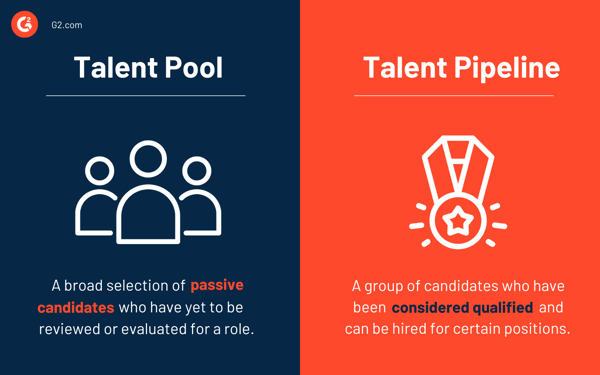January 27, 2021
 by Mara Calvello / January 27, 2021
by Mara Calvello / January 27, 2021

What if the right candidate for an open role is not only out there, but you already know who they are?
You’ve already spoken to them or even interviewed them to work at your company. For one reason or another, they didn’t make the cut – but they’re still interested in your organization.
These are the candidates that you may have in your company’s talent pool, which is a term used to describe a database with all of your current and potential job candidates. Within your talent pool will be not only people who have already applied for a job at your company, but also ones you’ve already sourced or even already interviewed, but came up second for the role.
It’s in your company’s best interest to invest in creating a talented pool of candidates so that when a certain role becomes vacant, you’re ready with a list of individuals who may still be interested.
A talent pool is a group of potential job candidates that could fill future open roles within your organization. For this, you need top-notch recruiters and sourcers who can build relationships with passive jobseekers. They also know where to find the most qualified and top candidates.
You can have one or many talent pools. These individuals have expressed interest in your organization at some point and are usually segmented by experiences, qualifications, and location.
A talent pipeline is where you direct candidates within your talent pool. It includes the systems and processes used to identify top talent and build relationships. Part of the pipeline is actually getting to know and interviewing the candidate over time, so you can better understand if the candidate is qualified.
Those within the talent pipeline are qualified and ready to be considered for certain roles. A pipeline is ideal for roles within an organization with a high turnover.
Essentially, a talent pipeline is where you’ll find candidates who were already deemed qualified for a certain role, whereas a talent pool is a broader group of candidates who have yet to be reviewed.

There are various types of talent pools your organization can create at once to be utilized when specific roles within your company become vacant.
These talent pools include:
There are many benefits to having a talent pool and many reasons as to why having one is vital to your company.
Imagine every time your organization had an open position to fill you had to go through the entire recruitment process. While yes, it’s doable, imagine how much easier hiring would be if you could dip into and pick the best or most qualified candidate.
When you’re able to utilize a previously built-out talent pool, you’ll shorten the time-to-hire. Meaning vacant roles within your organization stay vacant for less time, since you and your team are proactive within the process of finding talent. Instead of waiting for potential applicants to respond to a job post, all that’s needed from your HR team is to reach out to those they’ve already spoken to.
On the flip side, candidates within your talent pool are likely to have a better experience throughout the hiring process. When you put candidates who may fit a specific role type, that may be vacant in the future, into your talent pool it removes the need for rejection. This is because rather than rejecting a candidate on a specific job opening, you keep them in your mind for future jobs.
Having a better candidate experience will help your team build authentic and long-lasting relationships once they do join your organization.
A talent pool can also provide your company with a bit of a safety net, meaning if a role within your company becomes open unexpectedly, your talent pool is the first place you’ll turn to fill the role without having to launch into full-scale recruiting efforts.
And finally, a talent pool makes it possible to stay connected with passive candidates. A passive candidate is a person happy at their current company and will tell you they’re “not interested” when you try to reach out to them.
However, putting that individual in your talent pool ensures you stay connected should they change their mind. It gives them the chance to follow your company and keep tabs on any current news or vacancies, without feeling pressured to apply. You never know when an open position could be exactly what they’ve been waiting for.
When you’re ready to get started on building an effective talent pool for your organization, follow these steps to get started.
When you and your team have the right recruiting automation software at your disposal, building up to date talent pools for open and future roles is easier than ever. Thanks to artificial intelligence, these tools can identify qualified candidates, verify their email address and LinkedIn profile, and export a full candidate profile so all of their details are accurate.
As you go about candidate sourcing, you’ll likely find many people that are interested in your company or its open roles, but just don’t quite fit the requirements. When this happens, add them to your talent pool. Make sure to keep them updated on any relevant news surrounding your company and invite them to any conferences and events to keep them interested in joining your team.
of recruiters go back and hire candidates who at first didn't appear to be a fit.
Source: Jobvite
Another great way to build a talent pool full of qualified candidates is to take advantage of your company’s referral program. Candidates that are referred to your organization by current employees are known to stay longest at companies. Even if you don’t hire someone who was referred, keeping them in your talent pool will make filling a future open position that much easier.
In order to take your talent pool to the next level, you need to attract talented candidates through your recruitment marketing strategy. Recruitment marketing refers to the process of using marketing tactics to attract, engage, convert, and nurture job seekers to join your organization.
When done efficiently, not only will this expand on the candidates within your talent pool, but it will also allow your business to stand out amongst competitors.
If your website doesn’t have a landing page centered around the open careers at your organization and all of the perks employees get to enjoy, you’re missing out on attracting talent and building up your pool. A landing page will serve as an invitation to potential candidates to join your team and become a part of your talent community.
Not only can you have a list of open roles and an easy “apply now” button, but you can also entice job seekers with your employer branding and make sure they keep an eye out for potential roles that may open in the future.
Sometimes the best candidates are right in front of you.
No, really. You’re taking your coffee breaks with them and joining them in meetings. Current employees already know the ins and outs of your company, the employer brand, and fit in with the company culture. Because of this, they should be the first people you think of when hiring for senior-level roles.
Make sure you’re keeping current employees informed on all senior openings. When they’re a part of your talent pool, their managers will let you know if they have what it takes for a promotion.
When your talent pool is kept up to date, you never know who you’ll find to be a perfect fit for a newly vacant role. You’ll be surprised by how much faster you’ll be able to fill an open position when you take the time to maintain your talent pool. If you forget to keep in contact with these candidates, your talent acquisition strategy will likely fall off the deep end and get picked up by your competition.
When you’ve found the right candidate within your talent pool, become reacquainted and learn where they are now in their career by conducting a video interview at a time that fits their schedule.
Mara Calvello is a Content and Communications Manager at G2. She received her Bachelor of Arts degree from Elmhurst College (now Elmhurst University). Mara writes content highlighting G2 newsroom events and customer marketing case studies, while also focusing on social media and communications for G2. She previously wrote content to support our G2 Tea newsletter, as well as categories on artificial intelligence, natural language understanding (NLU), AI code generation, synthetic data, and more. In her spare time, she's out exploring with her rescue dog Zeke or enjoying a good book.
The world is powered by the experience economy, and it's time to take that to heart when it...
 by Varshini Ravi
by Varshini Ravi
As a recruiter, you know that finding the perfect candidate can feel like finding a needle in...
 by Mara Calvello
by Mara Calvello
Recruiting top talent is crucial to the success of any organization.
 by Mara Calvello
by Mara Calvello
The world is powered by the experience economy, and it's time to take that to heart when it...
 by Varshini Ravi
by Varshini Ravi
As a recruiter, you know that finding the perfect candidate can feel like finding a needle in...
 by Mara Calvello
by Mara Calvello


